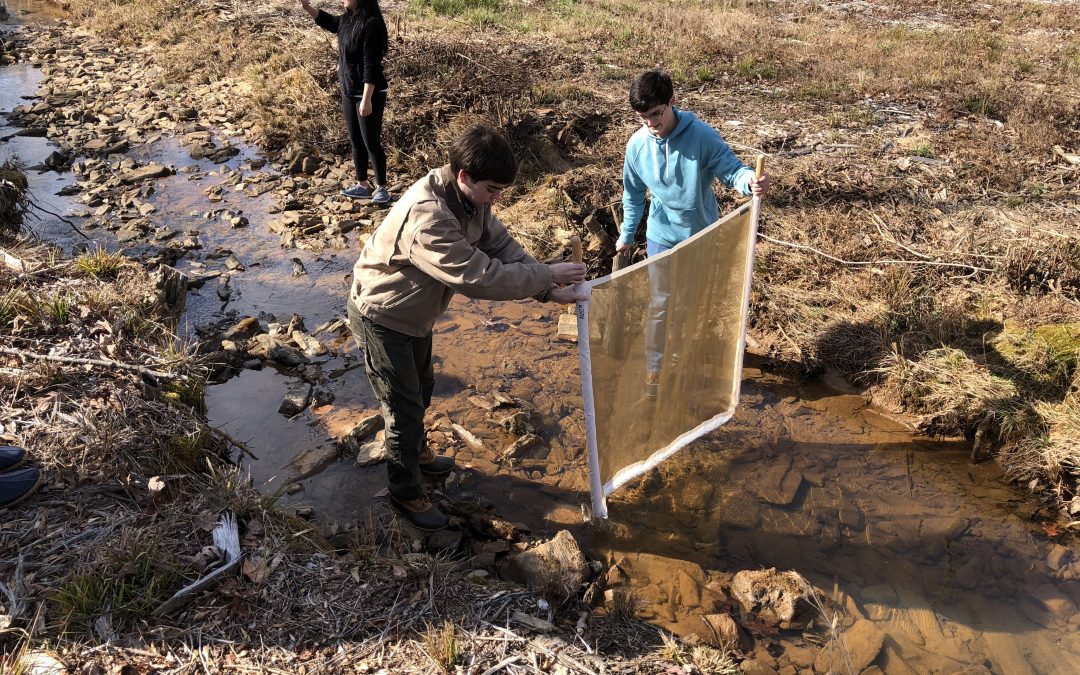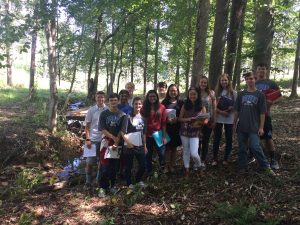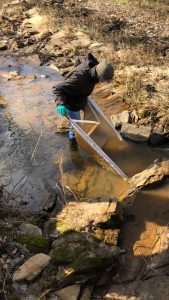By. Caley Bloodworth, science teacher, Auburn (Alabama) High School
“Peek into the new Auburn High School.” This headline appeared across our city, county, and state for several months leading up to and after the opening of the new, sustainable high school for Auburn, Alabama. While all students, teachers, administrators, and Auburn citizens were thrilled about the possibilities of this new LEED certified space, as an environmental science teacher I was excited about my new classroom lab space and even more excited about what lay outside of our beautiful, 350,000-square foot campus. Walking out the front doors of the main academic building you are greeted by a creek that runs the entire length of the campus. While I do think it enhances our campus’s beauty, the endless possibilities for outdoor science experiments gave me a new passion for teaching tenth through twelfth grade students AP Environmental Science and core environmental science classes.
Eight months before the campus doors opened, I started to brainstorm labs and projects that could utilize the creek on our new campus. At the time, Alabama Power was offering a grant designed to teach students how to be stewards of their environment. I have always tried to teach students how to be good stewards of the earth but obviously that lesson just does not have the same impact when sitting at a desk. I thought this grant was the perfect opportunity to write a proposal that focused our students’ stewardship on taking care of our local water sources and creek banks. Adding tools to create experiments studying water quality was a great opportunity to enhance the academic curriculum for all the environmental science courses. With administration in full support and grant approval in hand, we were prepared to get knee deep, literally, in our campus creek and start our yearlong project on water quality.
“Water, water, every where, [n]or any drop to drink,” an excerpt from The Rime of the Ancient Mariner poem from 1798, is such a powerful statement from 220 years ago that still holds true in regard to the importance of water. Scientific research shows that we are not gaining water but instead have the potential to experience fresh water shortages. The impact that students have on our future water supply is crucial. Therefore, the importance of teaching our students about water quality is a task that plugs us into the global future and our current community. Lab days have always been my favorite days of school, and the new campus location has enabled me to provide engaging outdoor opportunities that did not exist before. This academic year taking students out into the woods, walking along the creek bank, and wading into the water has made those lab days even more exciting. Most importantly, they provide our students with a sense of real importance as they compile important water quality data for their lab reports.
Throughout the school year, students have conducted chemical testing on the water looking at levels of nitrates and phosphates, pH levels, turbidity, and dissolved oxygen, as well as collecting macroinvertebrate samples periodically throughout the year to make correlations with the water quality and pollution in our city. Students also take soil samples along the creek banks to measure changes in chemical soil balance while also making observations of erosion and overall plant health. Assistant Principal Justina Wills spoke of her experience after joining students on a macroinvertebrate collection day.
“Auburn High School students, faculty, and staff have the beautiful privilege of looking out of the floor to ceiling glass windows that create our building, to experience a glimpse of nature at any given point in our day. Beyond that, some of our classes are taking an experimental approach to embracing the nature that surrounds us. Our environmental classes have begun to venture out to the creek and woods that surround us to set learning in action. I had the wonderful opportunity to join one of those classes in exploring the creek to collect samples for later experimentation. The excitement on the students’ faces as they worked together to collect samples or try to capture living organisms was amazing! Active engagement is a clear indicator of student learning, and it was so rewarding to witness them “knee deep” in learning their content.”
The chemical testing and macroinvertebrate collecting in our creek is teaching students which levels or specific macroinvertebrates indicate good and bad water quality. Students are learning to make correlations with the water quality, air pollution, the weather, and the health of the soil all based on our data and sample collections. However, starting an on-campus water quality project has taught students more than just field lab skills. It has allowed me to interweave other curriculum topics, such as human population, ecosystems, pollution, and energy, into our classroom discussions and lessons.
My hope is that through the study of water quality our environmental science students will become better stewards of our water supply by plugging them into our school’s environment, letting them connect to Auburn’s environment, and eventually seeing their role in the importance of our global water quality. As our water quality studies continue, I hope more students start to peek outside our building and into the creek to see the importance of studying water quality.
Author Bio
Caley Bloodworth is a science teacher at Auburn High School (AHS) in Auburn, Alabama – the Loveliest Village on the Plains. At AHS she has been given the opportunity to use her environmental chemistry background to start an AP Environmental Science program and grow the existing environmental science curriculum.



